Why Do Women Wear Hats in the Markets of Peru?
![]()
![]()
Chapter 1: Introduction to Women in Hats
Chapter 2: Men in Hats
Chapter 3: Conclusion of Why Women Wear Hats in the Market Place
Introductory Note: In June, 2002, Fran and I took a trip with Overseas Adventure Travel (OAT) to Peru, The Galapagos, and Ecuador. As you know, when I travel I like to take "Character" photos. Sometimes I get a winner; sometimes I get a loser; but I always get a story. When in Peru and Ecuador I tried hard and got some good shots. The following are copies of e-mail messages I sent out upon my return from this trip.
| Remember the original theme of this series was to discuss why women where hats in Peru. You may think that I have strayed from my story from time to time but it is important that you get the full picture before the final exam. As you can imagine, some of the women don't wear hats. | 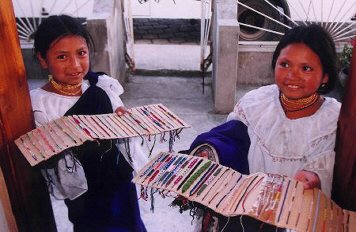 |
Naturally young girls do not wear hats. But as I have pointed out, take a look at the full dress of the people in my photos. These girls are selling magic wrist bracelets. Note their blouses and the gold chains around their necks. You should immediately recognize that these girls are in Ecuador, not Peru. The rule on hats remains the same regardless of the country you are in. These girls stopped to see us at a shop in Peguche where we could purchase beautiful wool wall hangings with scenes of Ecuador on them. |
| This was our second trip to the village - some people didn't make purchases on the first day and everyone readily agreed to return on the second day to shop some more. | 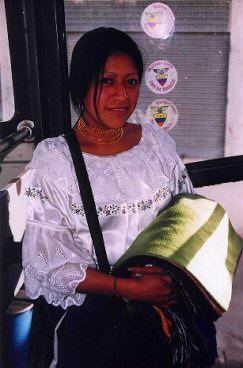 |
As we boarded the bus to return to Hacienda Cusin this young woman got on with us. Again, she is not wearing a hat but note her native dress - beautiful blouse, black skirt with a white stripe, and gold beads around her neck. As we drove to the hacienda she walked through the bus selling wonderfully colored soft silk/cotton scarves. |
| As I mentioned earlier young girls do not wear hats. In fact, unmarried women do not wear hats either. It is only after you marry that you are expected to wear a hat - thus while the color and design of the hat may designate your native tribe, it is also a status symbol and like medals on an army uniform it is a quiet statement of who you are and where you are from. |  |
So you say, "Bob, according to the above rule, this woman, is carrying her brother or sister on her back." Not so! A marriage is a big social event in every village and the couple is expected to invite everyone to the wedding. This of course can be very expensive. Accordingly, it is not unusual for a man and woman who intend to marry, to live together for several years, and maybe have several children, before they have saved enough money to have a church wedding with the accompanying feast. |
| So knowing what we do, what can we conclude about this woman who is standing in front of Iglesia Santo Domingo in Cuzco selling souvenirs? | 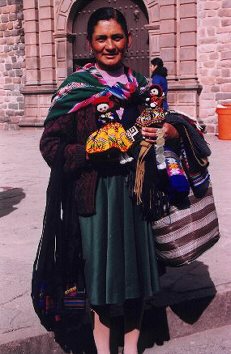 |
The church was originally El Templo del Coricancha - The Temple of the Sun - and the most magnificent complex in Cuzco. The walls were covered with 700 sheets of gold studded with emeralds and turquoise and the windows were constructed so that the sun would cast a near blinding reflection off the precious metals. The patio was filled with life-sized gold and silver statues of llamas, trees, fruits, flowers and even delicate butterflies. Naturally the Spanish took all the gold and melted it down to be sent to the King of Spain or to adorn the Catholic churches. Today the Temple of the Sun is enclosed within the walls of a Dominican monastery. |
| I know that many of you believe I have gone on and on and on about the Hats in Peru but there is a method in my madness. You have seen all sorts of hats and have had some history of why the women in Peru wear hats. My story is now coming to an end and I wish to explain what I was told as to why women have changed from the costumed hats of their native tribes to a less formal, and certainly not as decorative, hat as a simple fedora. |
 |
| Here you can see the two generations of adult women spinning wool into yarn. The elderly woman clings to her native costume hat while the younger one wears the more now traditional hat of a woman in the market place. This photograph was taken at the site of the sacred waters at Tambomachay. Tradition holds that the waters of this fountain would restore youthfulness and remove wrinkles from your face. We were all given the opportunity to wash our hands and faces in the miraculous waters. |
| I am told that Inca women who are trying to leave the tribe and move to the city and become part of the city life discard the wearing of the traditional native hat and instead where the felt hat which is less expensive. They don't discard the hat completely because they want to maintain some connection to their home village. If they decided to give up city life and return to their village they will be accepted back into the community. | 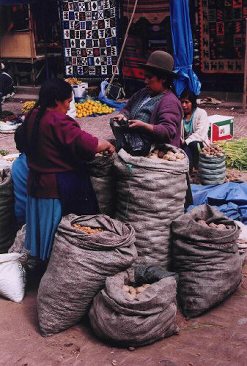 |
If however, they were to adopt totally the city dress this is looked upon as a renouncement of their local tribal culture and community and they can never go back. Thus once again the hat is a symbol of the woman's place in her society. Now this is what I have been told by our tour director, Maricella. I asked her more than once and her comments were always the same. I can only accept them as true. |
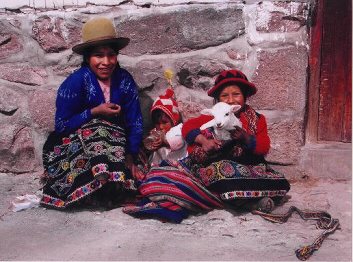 |
So now you know the story of why women in the market wear felt hats in Peru. They maintain their identity and yet preserve their lovely customs. And no matter how long you are gone, you want to keep the right to go home. | 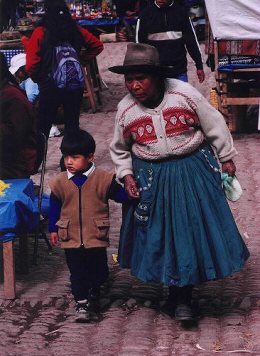 |
| It wouldn't be sufficient to suggest that all hats worn by women in the market mean the same thing. A man with a mission is very observant and one day, while walking through the main plaza in Cuzco, I noted a woman wearing a hat which was obviously very different from the other felt fedoras I had seen being worn by everyone else. | 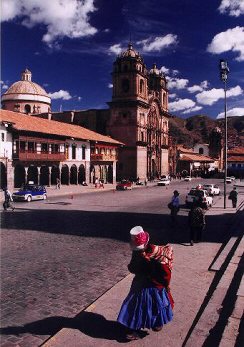 |
The hat is white and an unconventional top hat design. Upon further observation it seemed that most of the white hats were straw but some could be felt. Naturally I asked Maricella what this means. She told me that women who wear these hats are recognized as being the more successful merchants in the market place. They are the upper crust, you might say. |
| This character shot was taken in the Saturday open market in Pisac in the Sacred Valley of the Incas. Notice how she walks tall and with confidence. See the red yarn over her left arm? As she walks along the cobble stoned streets of the market place she is spinning wool into yarn from a spindle. Women who wear the white top hats are the upper crust of the market place society. | 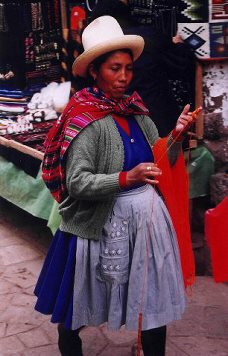 |
| This woman is selling the local corn. Not how many different varieties and colors there are. Peru grows something like 300 different varieties of corn and they have the largest kernels anywhere. Have you ever had salted corn nuts which are sold in the candy department of convenience stores? If not, go take a look at them some time and see how large the kernels are. The corn may come from Peru. The major market for the Peruvian corn is Japan. | 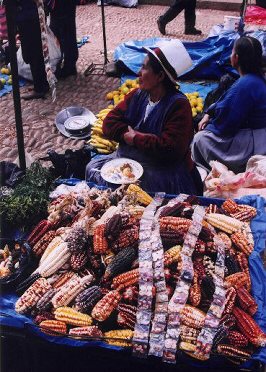 |
When we visited a local family for lunch, the place we were treated to guinea pig, we were also served "corn on the cob" from this type of corn. The cobs we were served were cut up into pieces about 3 inches long and there was so much corn even I could not eat it all. They serve cheese with their corn on the cob. Note the plastic bags hanging in front of the ears of corn. The bags are filled with samples of the different kinds of corn for tourists to take home. As tempting as it was, we couldn't buy these items because they would have been taken from us when we returned to the U.S. because they are "agricultural" items. |
| I asked Maricella why someone couldn't just throw away their brown fedora and put on a white hat? She looked at me in dismay wondering why anyone would even think of such a thing. She explained that you don't get to wear the white hat until you are accepted into that social structure. If you were not invited to join the group you would never be accepted. Also, your peers would know that you had not moved up and thus they would ostracize you from that group. To be shunned by everyone would be the worst of both worlds. |  |
I have truthfully reported to you what I learned about "Why women wear hats in the markets in Peru." Our tour director wouldn't tell me anything but the truth. If you question what I have written you are all invited to go to Peru on an Overseas Adventure Travel (OAT) tour and find out for yourself. |
If you have any questions about what you are seeing, or want some further information, feel free to
![]() send me a note.
send me a note.
